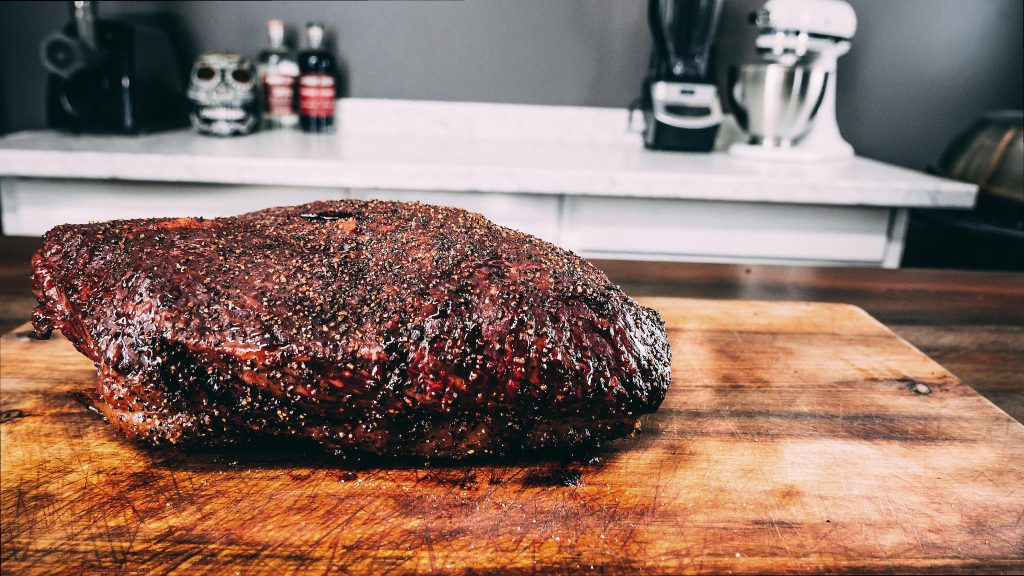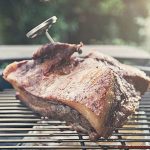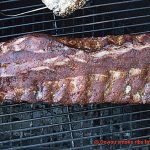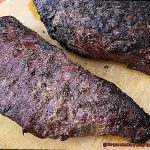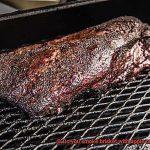If you’re a die-hard fan of this mouthwatering beef cut, then you know that smoking it just right is an art form. But here’s the burning question: should you smoke your tri-tip at a low and slow 225 degrees or crank it up to 250 degrees?
The temperature you choose can make all the difference in terms of tenderness, juiciness, and flavor explosion. Some folks swear by the leisurely 225-degree method, while others argue that a sizzling 250 degrees brings out even more deliciousness.
So grab a cold one, ignite that smoker, and let’s dive headfirst into the smoky world of tri-tip.
Contents
Pros and Cons of Smoking Tri-Tip at 225 Degrees Fahrenheit
In the realm of smoking tri-tip, there exists a heated debate regarding the ideal temperature. Some devout pitmasters swear by the low and slow method at 225 degrees Fahrenheit, while others find solace in a slightly higher temperature of 250 degrees. This article dives into the pros and cons of smoking tri-tip at 225 degrees Fahrenheit, enabling you to make an informed decision that will tantalize your taste buds.
The Pros of Smoking Tri-Tip at 225 Degrees Fahrenheit:
Tender and Juicy Meat:
At 225 degrees Fahrenheit, the cooking process is unhurried, resulting in tri-tip that is tender and succulent. Slowly rendering fat imbues the meat with flavor, creating an irresistible texture that will melt in your mouth.
Enhanced Flavor Profile:
The extended cooking time at 225 degrees Fahrenheit allows the smoke to infuse deep into the meat, adding a complex and smoky essence that will leave your taste buds dancing with delight.
Prevents Overcooking:
By gradually cooking the tri-tip, the risk of overcooking or drying out the meat diminishes. With careful attention, you can ensure that it reaches its desired internal temperature without sacrificing its tenderness.
The Cons of Smoking Tri-Tip at 225 Degrees Fahrenheit:
Longer Cooking Time:
Smoking at 225 degrees comes with the drawback of a longer cooking time. If you are seeking a quicker cook, consider raising the temperature to 250 degrees for a more expedited result.
Increased Monitoring:
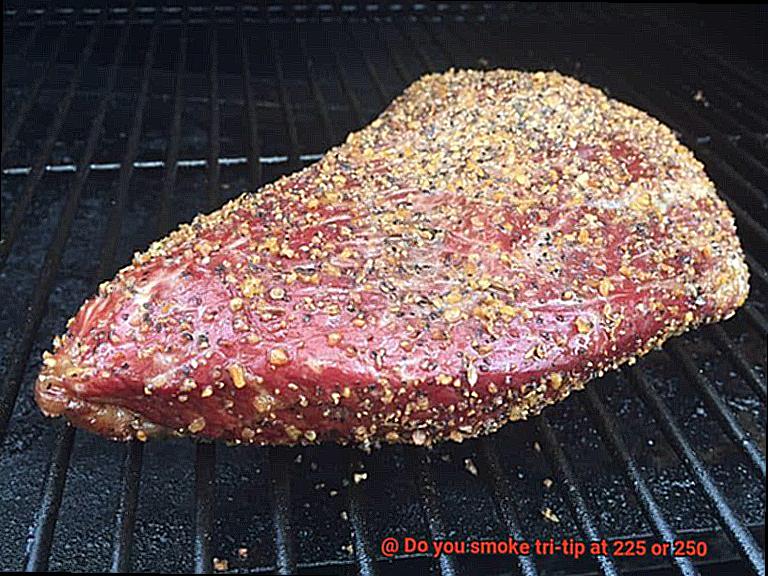
The lower temperature demands heightened vigilance and meticulous monitoring to maintain consistent heat levels throughout the cooking process. Keep a watchful eye to prevent fluctuations that may compromise the final outcome.
Less Crispy Exterior:
While smoking tri-tip at 225 degrees Fahrenheit yields tender and juicy meat, it may not achieve the same level of crust or bark as higher temperatures. If a crispy exterior is paramount to you, consider opting for 250 degrees Fahrenheit.
Considerations
Ultimately, the decision to smoke tri-tip at 225 or 250 degrees Fahrenheit hinges on personal preference, time constraints, and experience with smoking. If tenderness and a smoky flavor are your priorities, 225 degrees is the path to follow. However, if you crave a more expedient cook or desire a more pronounced crust, then 250 degrees may be your preferred avenue.
Regardless of your chosen temperature, maintaining consistent heat levels and utilizing a reliable smoker or grill are paramount. Remember to employ a meat thermometer to monitor internal temperature and allow the tri-tip to rest before slicing to unlock maximum tenderness.
Pros and Cons of Smoking Tri-Tip at 250 Degrees Fahrenheit
Smoking tri-tip at 250 degrees Fahrenheit brings both advantages and disadvantages to the table. On the positive side, smoking at this temperature can save you valuable time. The higher heat results in a faster cooking time, which is perfect for those occasions when you have a hungry crowd waiting. Additionally, the elevated temperature promotes a more pronounced Maillard reaction. This chemical process creates rich flavors and a beautiful crust on the surface of the tri-tip, adding depth and complexity to the taste.
Another benefit of smoking at 250 degrees Fahrenheit is that it produces juicier meat. Lean cuts like tri-tip have a tendency to dry out easily, but cooking at a higher temperature helps seal in the juices, resulting in a moist and tender final product. Your guests will be left raving about the succulent and flavorful tri-tip you served them.
However, there are also some drawbacks to consider. One potential risk of smoking at 250 degrees Fahrenheit is overcooking. The higher temperature leaves less room for error, so it is crucial to closely monitor the internal temperature of the meat to avoid turning it into shoe leather. Investing in a reliable meat thermometer and keeping a watchful eye on your creation is essential.
Another downside is that smoking at this temperature may result in a slightly milder smoke flavor compared to lower temperatures. Lower temperatures allow for prolonged exposure to smoke, resulting in a stronger smoky taste. If you are a smoke fanatic, you might want to compensate by using wood chips or chunks with more robust flavor profiles.
Lastly, higher temperatures can increase the likelihood of uneven cooking. If your smoker does not distribute heat evenly or if you place the tri-tip in a hot spot within the smoker, you may end up with some areas that are overcooked while others are undercooked. To ensure consistent cooking throughout, make sure to rotate and position the meat properly during the smoking process.
Factors to Consider When Deciding What Temperature to Smoke Tri-Tip
Prepare for a mouthwatering journey as we delve into the factors that determine the ideal smoking temperature for tri-tip. Smoking this delectable cut of meat requires careful consideration of various elements. In this article, we will explore the key factors to consider when deciding on the temperature for smoking tri-tip. So, put on your apron and let’s embark on a culinary adventure.
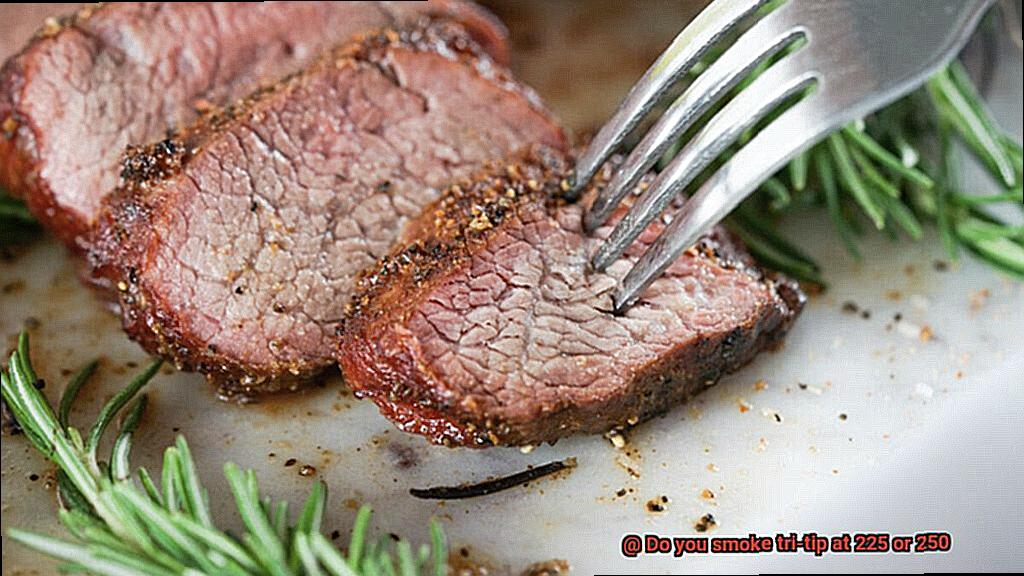
Factor 1: Thickness Matters
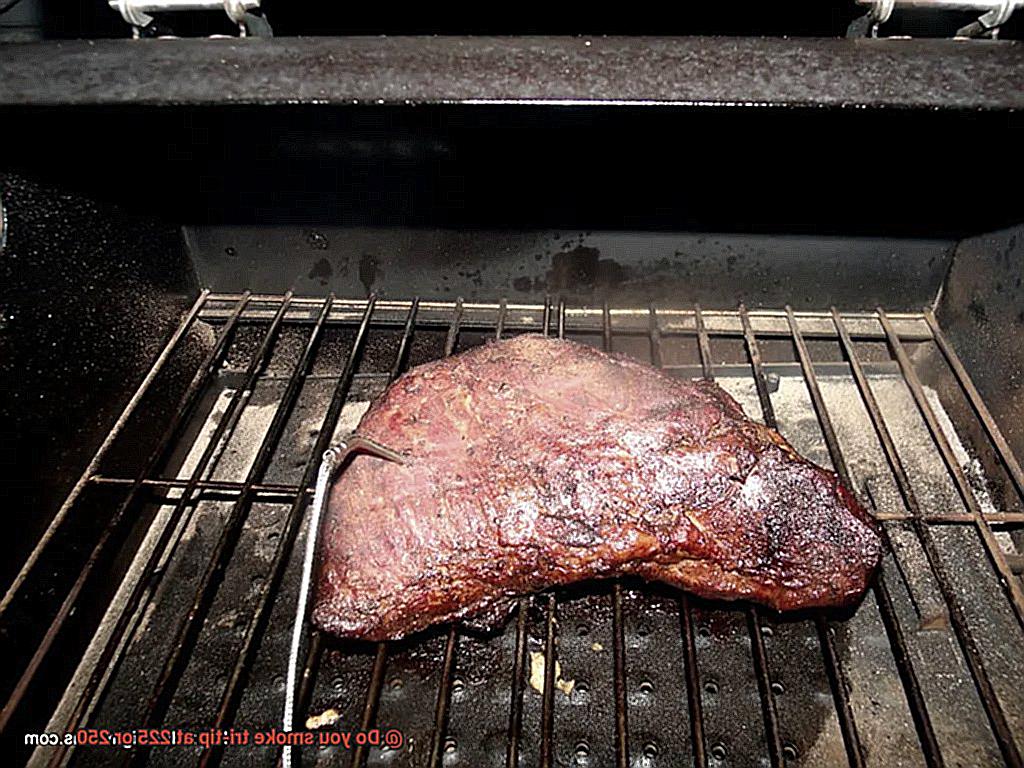
The thickness of your tri-tip is a crucial factor in determining the smoking temperature. Thicker cuts require lower temperatures to ensure even cooking. You don’t want the outer layer to be overcooked while the center remains underdone. For thicker tri-tips, aim for a smoking temperature around 225°F.
Factor 2: Time Constraints and Heat Intensity
If time is of the essence and you need to smoke your tri-tip quickly, a higher temperature of 250°F may be more suitable. The intense heat will expedite the cooking process, resulting in shorter overall cooking time. However, be vigilant as there is a higher risk of drying out the meat if not monitored closely.
Factor 3: Texture and Tenderness Delight
The temperature you choose can significantly impact the texture and tenderness of your tri-tip. Smoking at a lower temperature, such as 225°F, allows for a slow cooking process that breaks down collagen and connective tissues, resulting in tender and succulent meat. Conversely, smoking at 250°F can yield a slightly firmer texture with a tantalizing crispy outer crust.
Factor 4: Know Your Smoker
Each smoker has its own distinct characteristics and efficiency levels. Understanding your smoker’s quirks and capabilities is crucial in choosing the smoking temperature for your tri-tip. Some smokers distribute heat unevenly or have varying heat retention abilities. By familiarizing yourself with your smoker, you can make necessary adjustments to achieve the desired results.
Factor 5: Personal Preference Reigns
Last but not least, personal preference plays a vital role in determining the smoking temperature for your tri-tip. Whether you prefer a medium-rare, medium, or well-done tri-tip, experimenting with different temperatures will help you discover your preferred level of doneness and flavor profile.
The Benefits of Using a Reliable Smoker or Grill with Accurate Temperature Control
If you’re ready to elevate your grilling game, it’s time to invest in a reliable smoker or grill with accurate temperature control. The benefits of using such a device are numerous and will revolutionize the way you approach cooking your favorite meals.
One of the most significant advantages of using a reliable smoker or grill with accurate temperature control is precision cooking. Achieving the perfect smoked tri-tip requires maintaining a consistent temperature. Different cuts of meat demand different cooking temperatures, and being able to adjust and maintain the temperature accurately ensures that your tri-tip is cooked to perfection. No more worrying about undercooked or overcooked meat – with a reliable smoker or grill, you’ll have complete control over the temperature.
But precision cooking is just the beginning. Using a smoker or grill with accurate temperature control also allows for better flavor development. Slow-cooking meat at lower temperatures allows the flavors to penetrate deep into the meat, resulting in a more flavorful and tender tri-tip. With accurate temperature control, you can ensure that your meat is smoked at the ideal temperature, allowing for maximum flavor infusion. Your taste buds will thank you for the explosion of mouthwatering flavors.
Food safety is another vital aspect to consider. Cooking meat at lower temperatures can increase the risk of bacterial growth, while cooking at higher temperatures can result in dry and overcooked meat. That’s where a reliable smoker or grill with accurate temperature control shines. By maintaining a safe and consistent temperature, you can rest easy knowing that your tri-tip is not only delicious but also safe to eat.
Last but not least, using a smoker or grill with accurate temperature control makes the whole cooking process easier and more convenient. No more constantly monitoring and adjusting the temperature manually – simply set the desired temperature on your trusty smoker or grill and let it do all the work for you. This gives you more time to focus on other aspects of preparing your tri-tip, like seasoning or preparing side dishes. It’s a win-win situation that allows you to enjoy the grilling experience to the fullest.
How to Monitor the Internal Temperature of the Tri-Tip
Smoking tri-tip is a tantalizing adventure that unlocks the true flavors of this succulent cut of meat. But before embarking on this smoky journey, there’s a burning question that demands an answer: should you smoke your tri-tip at 225 or 250 degrees Fahrenheit? Let’s delve into both options and discover which temperature aligns with your grilling style and taste preferences.
Smoking at 225 Degrees Fahrenheit: Low and Slow
Smoking tri-tip at 225 degrees Fahrenheit has long been a favorite among pitmasters and BBQ enthusiasts alike. The low and slow cooking method tenderizes the meat gradually, resulting in mouthwatering tenderness that melts in your mouth. At this temperature, the collagen in the tri-tip breaks down slowly, transforming tough connective tissue into delectable morsels of delight.
Not only does smoking at 225 degrees Fahrenheit create tender meat, but it also infuses a rich smoky flavor. The extended cooking time allows the meat to absorb the smoky goodness from your choice of wood chips or chunks. The result? A tri-tip that bursts with flavor and boasts an impressive smoke ring to wow your guests.
Smoking at 250 Degrees Fahrenheit: A Crispy Outer Crust
If you’re seeking a slightly different twist on your smoked tri-tip, consider cranking up the heat to 250 degrees Fahrenheit. This higher temperature can help develop a crispy outer crust or bark on the meat while still maintaining its tenderness inside. The faster cooking time at this temperature may also be advantageous if time is of the essence or if you prefer a slightly more well-done tri-tip.
Smoking at 250 degrees Fahrenheit presents a great option for those who crave the perfect balance between tenderness and a flavorful exterior. The higher heat creates a savory crust that adds an extra layer of texture to your tri-tip. Plus, it saves you precious time if you’re in a hurry to get dinner on the table.
Choosing the Right Temperature for You
Having explored both options, how do you decide which temperature is best for smoking your tri-tip? It ultimately boils down to personal preference and cooking style. Consider factors such as the desired texture, available time, and the flavor profile you wish to achieve.
If you adore tender, melt-in-your-mouth meat and have the luxury of time, smoking at 225 degrees Fahrenheit is the way to go. The slow cooking process yields a tri-tip that oozes juiciness and packs a punch of smoky flavor.
On the flip side, if you yearn for a slightly different texture and are pressed for time, smoking at 250 degrees Fahrenheit can be an excellent choice. The higher heat delivers a beautifully seared crust while still keeping the inside of the tri-tip succulent and tender.
Tips for Ensuring Maximum Tenderness in the Meat
If you’re a grilling enthusiast looking to create a mouthwatering, tender smoked tri-tip, you’ve come to the right place. Achieving maximum tenderness in this cut of meat requires some careful techniques and attention to detail. In this guide, we’ll walk you through five essential tips to ensure your smoked tri-tip is nothing short of perfection.
Start with selecting a good quality tri-tip cut: The tenderness of the meat starts with the selection of the right cut. Look for a well-marbled tri-tip with even thickness throughout. This will ensure that the meat cooks evenly and results in a tender texture. Marbling refers to the fat interspersed within the muscle fibers, and it plays a crucial role in keeping the meat moist and tender during the smoking process.
- Tenderizing techniques: To further enhance tenderness, consider using some tenderizing techniques before smoking the tri-tip. One popular method is marinating the meat overnight in a mixture of acidic ingredients like vinegar, lemon juice, or buttermilk. The acid helps break down the tough fibers in the meat, resulting in a more tender texture. Another technique is using a meat tenderizer tool to physically break down the muscle fibers and make the meat more tender.
-
Cook low and slow: When it comes to smoking tri-tip, low and slow is the secret to maximum tenderness. Maintain a low temperature throughout the smoking process, typically around 225 to 250 degrees Fahrenheit. Cooking at this low temperature allows the collagen in the meat to break down slowly, resulting in a more tender texture. Be patient and avoid rushing the cooking process by increasing the temperature, as this can lead to tougher meat.
- Resting period: After your smoked tri-tip reaches the desired internal temperature, it’s crucial to let it rest before slicing. This resting period allows the juices to redistribute within the meat, resulting in a more tender and flavorful final product. Cover the tri-tip loosely with aluminum foil and let it rest for at least 10 to 15 minutes before slicing. This step is often overlooked but can make a significant difference in the tenderness of the meat.
- Slice against the grain: To further enhance tenderness, it’s essential to slice the tri-tip against the grain. The grain refers to the direction of the muscle fibers in the meat. Cutting against the grain means slicing perpendicular to these fibers, which helps shorten them and makes each bite more tender.
Experimenting With Different Temperatures and Techniques
Get ready to elevate your smoking game as we delve into the captivating world of experimenting with different temperatures and techniques when smoking tri-tip. This is where the magic happens, so grab your favorite beverage and join us on this flavorful journey.
The Temperature Dilemma:
Temperature is the key to smoking tri-tip to perfection. But which temperature should you choose? Let’s break it down, exploring the advantages of two popular options: 225°F and 250°F.
a. The Slow and Smoky Approach (225°F):
At a lower temperature of 225°F, you’ll embark on a slow and tantalizing cooking process. This allows the meat to luxuriate in the embrace of delightful smoky flavors, resulting in a taste that will make your taste buds sing in harmony. Moreover, the connective tissues have ample time to gracefully surrender, leaving you with a tri-tip that’s tender, juicy, and utterly divine.
b. The Speedy Crust (250°F):
For those who crave a slightly crisper exterior or find themselves pressed for time, 250°F is the way to go. This elevated heat expedites the cooking process while preserving the juiciness we all cherish. The result? A mesmerizing crust that adds an irresistible texture to your tri-tip, creating a symphony of flavors with each bite.
Personal Preferences and Smoker Variations:
Remember, your preferences and familiarity with your smoker also play a role in finding the ideal temperature. Not all smokers are created equal. Some may have slight variations in temperature accuracy, making it crucial to rely on a reliable thermometer for precise monitoring.
Size Matters:
Let’s not forget about the size and thickness of your tri-tip. Thicker cuts require slightly lower temperatures to ensure even cooking throughout. Keep this in mind when deciding on your perfect smoking temperature.
The Art of Experimentation:
Ah, the beauty of experimentation. It’s time to put your grilling skills to the test. Try smoking your tri-tip at both 225°F and 250°F to savor the nuances and compare the results. Take notes, immerse yourself in the flavors, and let your taste buds guide you toward your preferred method. Remember, it’s all about finding what suits your unique palate.
Consistency is Key:
No matter which temperature you choose, maintaining a consistent heat throughout the smoking process is vital. Fluctuations can lead to uneven cooking, leaving you disheartened. So keep an eagle eye on that thermometer and adjust as needed to ensure a mouthwatering masterpiece.
__3RXuTqrKw” >
Conclusion
When it comes to smoking tri-tip, there’s a constant debate about the ideal temperature: 225 or 250 degrees Fahrenheit? Well, let me tell you, my friend, it all depends on your personal preference and desired outcome.
If you’re aiming for a tender and juicy piece of meat with a melt-in-your-mouth texture, then smoking at 225 degrees Fahrenheit is your ticket to flavor town. This low and slow approach allows the fat to render slowly, resulting in a succulent tri-tip that practically falls apart with each bite. The smoke gently permeates the meat, infusing it with a deliciously smoky aroma that will have your taste buds dancing with joy.
On the other hand, if you’re looking for a slightly crisper exterior and a more pronounced smoky flavor, bumping up the temperature to 250 degrees Fahrenheit might be more up your alley. This higher heat will give you a beautiful crust on the outside while still maintaining that tender goodness on the inside. It’s like getting the best of both worlds – a little bit of char and a whole lot of tenderness.
Ultimately, whether you choose 225 or 250 degrees Fahrenheit, what truly matters is giving your tri-tip ample time to cook and develop those mouthwatering flavors. Patience is key when it comes to smoking meat, my friend. So sit back, relax, and let the magic happen as your tri-tip transforms into barbecue perfection.
In conclusion, there’s no definitive answer to whether you should smoke tri-tip at 225 or 250 degrees Fahrenheit. It all boils down to personal preference and what kind of experience you want from your smoked meat adventure. Experimentation is encouraged. So fire up that smoker and let your taste buds be the judge.
You may also like:



